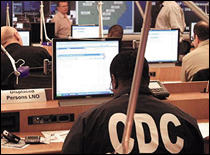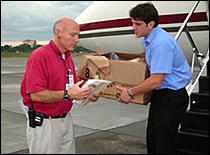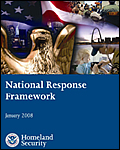Coordinating Office for Terrorism Preparedness and Emergency Response (COTPER)
CDC Emergency Operations Center (EOC)
 When a disaster occurs, CDC must respond effectively to support international, national, state, local, tribal, territorial, and private sector public health emergency response partners. A critical component of CDC’s work during an event is to coordinate response activities and provide resources to state and local public health departments. During the terrorist attacks of 2001, CDC headquarters for response activities consisted of available conference rooms with limited equipment. The Emergency Operations Center (EOC) was established in 2003 to serve as CDC's command center for monitoring and coordinating CDC’s emergency response to public health threats in the United States and abroad.
When a disaster occurs, CDC must respond effectively to support international, national, state, local, tribal, territorial, and private sector public health emergency response partners. A critical component of CDC’s work during an event is to coordinate response activities and provide resources to state and local public health departments. During the terrorist attacks of 2001, CDC headquarters for response activities consisted of available conference rooms with limited equipment. The Emergency Operations Center (EOC) was established in 2003 to serve as CDC's command center for monitoring and coordinating CDC’s emergency response to public health threats in the United States and abroad.
What are the functions of the EOC?
The EOC allows CDC to maintain situational awareness of public health-related events at the international, national, state, and local levels. Staffed around-the-clock, it serves as CDC’s central point of contact for reporting public health threats, and supports the Department of Health and Human Services (HHS) Secretary's Operations Center.
During an emergency response, the EOC brings together scientists from across CDC to efficiently exchange information and connect with public health emergency response partners. For multi-state or severe emergencies, CDC provides additional public health resources and coordinates response efforts across multiple jurisdictions, both domestically and abroad. The improved 24,000-square-foot EOC facility which became operational in 2006 can accommodate up to 230 personnel per shift when fully staffed for two to three shifts per day to  handle situations ranging from local interests to worldwide events. CDC’s Division of Emergency Operations (DEO) manages the EOC.
handle situations ranging from local interests to worldwide events. CDC’s Division of Emergency Operations (DEO) manages the EOC.
To support state and local efforts during an emergency response, EOC staff coordinates deployment of CDC staff and equipment that CDC responders may need. In addition, the EOC has the capability to transport life-supporting medications, samples/specimens, and personnel at any time anywhere in the world via aircraft that can be launched within 2 hours of notification for domestic and 6 hours for international responses.
How does the EOC operate?
When the EOC receives information about an event or incident, a preliminary assessment team of subject matter experts from across CDC is convened to recommend the scope of the response. The team’s assessment is reported to the Director of the Coordinating Office of Terrorism Preparedness and Emergency Response who then advises the CDC Director of the situation and provides recommendations for action, including a request for activation of the EOC.
 CDC uses the Incident Management System to manage responses to events. IMS is based on the Incident Command System and the National Incident Management System, both of which are universal and standardized emergency response operating systems used around the country. CDC and all 50 states have trained public health officials on their specific roles and responsibilities during an emergency as outlined by Incident Command System. This training helps ensure that CDC field response teams operate effectively as part of the state or local response structure.
CDC uses the Incident Management System to manage responses to events. IMS is based on the Incident Command System and the National Incident Management System, both of which are universal and standardized emergency response operating systems used around the country. CDC and all 50 states have trained public health officials on their specific roles and responsibilities during an emergency as outlined by Incident Command System. This training helps ensure that CDC field response teams operate effectively as part of the state or local response structure.
During an activation, the Incident Management System is led by the Incident Manager, who manages the response in collaboration with teams of experts pulled from across CDC to work with EOC core personnel. Emergency operation plans developed by CDC describe the roles and responsibilities of different offices, centers, and institutes across the agency during an emergency. CDC has an all-hazards base plan (Emergency Operations Plan) that outlines core roles and responsibilities for all-hazard responses, as well as plans for scenario-specific events such as hurricanes.
EOC staff also serve as the initial point of contact to communicate with public health emergency response partners who provide support to the on-scene Incident Commander. The Incident Commander is responsible for the on-scene incident response, including control of resources and resolution of on-scene issues.
What public health-related events have activated a CDC response?

CDC Public Health Responses Since 2001
2009: Salmonella typhimurium outbreak; Presidential Inauguration; H1N1 Influenza
2008: Satellite intercept; Salmonella and E. coli outbreaks; Hurricane Dolly; Tropical Storm Edouard; Hurricanes Gustav, Hanna, and Ike
2007: XDR/MDR TB Patient; Hurricane Dean
2006: Mumps; Tropical Storm Ernesto; E. coli outbreaks, Botulism Outbreak, Mycoplasma Pneumonia
2005: Presidential Inauguration, Marburg virus; Hurricanes Katrina, Rita, and Wilma
2004: Avian Influenza, BioWatch, Influenza vaccine shortage; Guam typhoon; Ricin; Citites Readiness Initiative, G8 Summit; Summer Olympics; Democratic National Convention; Republican National Convention; Hurricanes Charley, Frances, Ivan, and Jeanne; West Nile Virus; Tsunami
2003: Columbia Space Shuttle Disaster; SARS; Monkeypox; Northeast blackout; Hurricane Isabel; Domestic Influenza; California wildfires; Ricin; Tularemia; Anthrax; BSE (Mad Cow Disease)
2001: World Trade Center Attacks; Anthrax Attacks
EOC exercises. In additional to responding to real world events, CDC also conducts exercises to enhance the agency’s response capabilities. Examples of agency-wide exercises that CDC has conducted to test its response plans include simulated hurricanes, detonation of radiological dispersal devices (i.e., dirty bombs), and an outbreak of pandemic influenza.
What determines CDC involvement in public health response activities?
The Robert T. Stafford Disaster Relief and Emergency Assistance Act (Public Law 100-707) determines whether CDC and other federal agencies assist with matters that affect states and localities. The Stafford Act is a U.S. federal law designed to provide an orderly and systemic means of providing federal disaster assistance to state and local governments. The Stafford Act, a 1988 amended version of the Disaster Relief Act of 1974 (Public Law 93-288), created the system in place today by which a Presidential Disaster Declaration triggers financial and physical assistance through the Federal Emergency Management Agency (FEMA). The act gives FEMA the responsibility for coordinating government-wide relief efforts.
 The National Response Framework (NRF), successor to the National Response Plan (NRP), identifies the roles and responsibilities of 28 federal agencies, including CDC, and nongovernmental organizations, such as the American Red Cross, during federal disaster response operations. State and local governments have primary responsibility for incident response, with federal assistance provided in accordance with the NRF and Stafford Act if the event or incident exceeds their capabilities.
The National Response Framework (NRF), successor to the National Response Plan (NRP), identifies the roles and responsibilities of 28 federal agencies, including CDC, and nongovernmental organizations, such as the American Red Cross, during federal disaster response operations. State and local governments have primary responsibility for incident response, with federal assistance provided in accordance with the NRF and Stafford Act if the event or incident exceeds their capabilities.
- Page last reviewed March 31, 2009
- Page last updated March 31, 2009
- Content source: Coordinating Office for Terrorism Preparedness and Emergency Response (COTPER)
Get email updates
To receive email updates about this page, enter your email address:
Contact Us:
- Centers for Disease Control and Prevention
1600 Clifton Rd
Atlanta, GA 30333 - 800-CDC-INFO
(800-232-4636)
TTY: (888) 232-6348
24 Hours/Every Day - cdcinfo@cdc.gov

